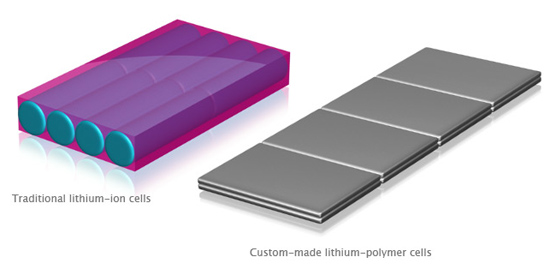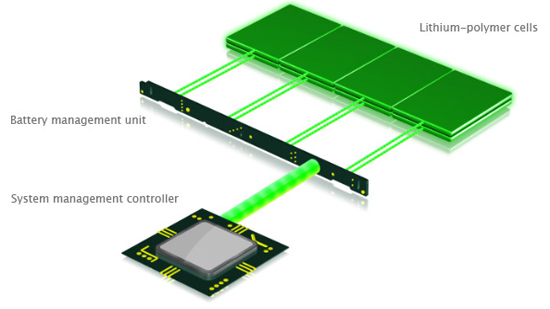Apple's 2009 MacBook Pro: Battery Life to Die For
by Anand Lal Shimpi on June 12, 2009 12:00 AM EST- Posted in
- Mac
I was so focused on the iPhone 3GS and Snow Leopard announcements from this year’s WWDC that I almost missed the gravity of the MacBook Pro announcements.
Apple announced price drops on nearly all of its laptops. The new lineup looks like this:
| MacBook | MacBook Pro 13-inch | MacBook Pro 15-inch | MacBook Pro 17-inch | |
| CPU | Core 2 Duo 2.13GHz | Core 2 Duo 2.26GHz | Core 2 Duo 2.53GHz | Core 2 Duo 2.8GHz |
| GPU | NVIDIA GeForce 9400M | NVIDIA GeForce 9400M | NVIDIA GeForce 9400M | NVIDIA GeForce 9400M + 9600M |
| Memory | 2GB DDR2 | 2GB DDR3 | 4GB DDR3 | 4GB DDR3 |
| HDD | 160GB | 160GB | 250GB | 500GB |
| Battery Life | Up to 5 hours | Up to 7 hours | Up to 7 hours | Up to 8 hours |
| Price | $999 | $1199 | $1699 | $2499 |
If you want an all aluminum body, you have to buy a MacBook Pro. There’s only a single MacBook model and it’s the white chassis that’s been around for a while now.
Apple added a 13” MacBook Pro to the lineup to fill in the gap, although it’s not clear to me whether this 13” MacBook Pro uses the same LCD panel as the old 13” aluminum MacBook or a derivative of the 15” MacBook Pro’s panel, which is superior.
 Of course there are different models within each one of these categories that you can purchase, but they are irrelevant to the discussion we’re about to have. Look at the battery life row in the table above; Apple is claiming up to 7 hours of battery on the new MacBook Pros. The old specs used to be up to 5 hours.
Of course there are different models within each one of these categories that you can purchase, but they are irrelevant to the discussion we’re about to have. Look at the battery life row in the table above; Apple is claiming up to 7 hours of battery on the new MacBook Pros. The old specs used to be up to 5 hours.
Apple did some clever work on its own here. Standard lithium ion batteries are made up of cylindrical cells, similar to AA batteries. The problem with these batteries is that they waste a lot of space within a notebook (try cramming a lot of cylinders into a box, you end up with wasted space). This wasted space translates into larger batteries than are necessary, which makes for larger notebooks.
In order to continue to drive laptop thinness down, Apple started experimenting with using custom lithium polymer batteries instead of the industry standard lithium ion parts. Lithium polymer cells aren’t made of cylindrical cells (they’re rectangular), so there’s no wasted space. Not only does this make the batteries more compact, but it also gives you greater capacity since you’re using all available chassis volume for the battery.

Makes sense. Courtesy, Apple.
Apple also found that it was wasting space in the removable enclosure for the batteries as well, so its lithium polymer offerings are no longer user removable. I suspect this part of the equation has more to do with cutting costs than saving space though.
Apple first used this lithium polymer battery technology in its MacBook Air. It gave Apple a very thin battery that allowed it to create the MacBook Air’s sweet form factor. Then came the new 17” MacBook Pro, without a removable battery. Apple claimed that this battery would last for five years before it needed replacing and resulted in up to an 8 hour battery life.

The extended life is supposedly due to an on-battery sensor that communicates with the system's management controller that can dynamically sense the needs of each lithium polymer cell and feed that info back to the charging circuitry. The result is slight variations in charging current designed to optimally charge each and every cell; apparently reducing wasted charge cycles significantly. Apple claims that most cells will hit 80% of their life after 200 - 300 charge cycles, but its special lithium polymer batteries will hit the 80% mark after as many as 1000 charge cycles. Apple claims its unique battery chemistry and microprocessor managed charging (Adaptive Charging) is responsible for these gains but it’s a difficult statement to prove; we’ll have to wait and see what happens after a few years of use.










113 Comments
View All Comments
sxr7171 - Sunday, June 14, 2009 - link
While OSX may be nice, there are far better machines with better battery life, lighter, thinner, sturdier and much better materials (magnesium alloy, carbon fiber) and a removable battery so you can swap out fully charged batteries for all day computing.Apple's laptop hardware is overhyped.
Pirks - Sunday, June 14, 2009 - link
Words, empty baseless words from another one of a legion of DT wintrolls. No proof, nothing. Keep posting stupidity without any proof, I enjoy that. Or give some model names, specs, something concrete. Nah, you can't, you can only bark. You can't bite ;)Johnmcl7 - Sunday, June 14, 2009 - link
It's all there if you want to read it but I suspect you'd rather not as that would hurt too much. However I'm typing this on an old Sony TX1HP/W with a BPL5 and BPS5 battery which is good for aroud 18 hours of battery, before you start whining about performance the AT conclusion makes no such reference. I should also note this machine is smaller and lighter than a Macbook Air, packs in an optical drive and more ports. It was also one of the first laptops with an LED backlit screen long before Apple were making a song and dance about it.If you want to see genuine innovation Sony are a good place to start because there's a good chance that in a couple of years time their current features will be a new 'innovation' in an Apple system a few years down the line.
SansSociety - Sunday, June 14, 2009 - link
I dunno where you guys get these outrageous 10+ hour battery life figures from. My Thinkpad T60 with the 9 cell (6 months old) gets no where close to 10 hours. I doubt you guys are getting the type of endurance you claim from T43s and the Sony TX's. 18 hours on the TX with extended battery? Come on... Time it.physics - Saturday, June 13, 2009 - link
Your results are consistent with what I've been getting on my 2 month old 17" MBP. My machine has the BTO 2.93 Ghz processors & 7200 rpm HD options and reports a projected 10 hour battery life endurance on my light usage off the plug. My current usage pattern is a split dual Unix terminal with iTunes playing songs from my HD and the integrated GPU(NV 9400) active. I believe that this projection is pretty accurate, since after about a couple of hours on the battery I get a projected endurance of about 8 hours. The coffee shop where I use this mode has no outlets for the customers and there are no unlocked WiFi routers within range.With Airport on and normal internet access, with streaming internet audio, I would expect to see battery endurance figures down to about 8 or 9 hours. It's refreshing to see a manufacturer publishing honest performance figures on their products, makes me more inclined to believe their advertising claims on future products. I'm salivating for the quad-core 17" MBPs on the 32-nm process next year.
cvt - Saturday, June 13, 2009 - link
There is no way apple should be bragging about Li-Pol.Its not a good, special, amazing, whatever move, its years late.
They should be ashamed it has taken so long for them to bother.
As for other notebook makers....
I think this is all dismally pathetic, especially that it deserves a story. Li-Pol have been around for years, have proven themselves in harsh conditions, and to be safe for many years. This "custom made" etc... is sickening, trying to make it sound as if they did something special. There marketing should be more along the lines of "sorry it took us so many years to bother trying a different type of battery, but we were scared". At least there'd be some honesty in it then.
Pirks - Saturday, June 13, 2009 - link
I wish any other WinPC maker got really scared and produced a notebook of the same specs/weight/size with the same stellar battery efficiency as new MBP. Could you scare them for me, cvt? Puhleeaase? With sugar on top! :))goku - Saturday, June 13, 2009 - link
Great, so Apple boosted their usage times by putting a larger capacity battery via replacing with the easy to replace and cheaper Lion cell batteries with the Lion Polymer batteries which aren't replaceable. This Macbook is nothing special, with my IBM T42 and its 15" screen, 55whr battery and its 9600pro, I got around 7-8 hours doing the exact same thing and with a drive bay add-on battery (23whr) I got 12 hours. So while Apple got 7 hours on 73whr battery, I got 12 hours, mind you the T42 has R9600pro and Intel Pentium M 1.7.chumbud - Saturday, June 13, 2009 - link
Would you people quit comparing portables that are either 1) substantially slower in speed, 2) smaller screen size, 3) smaller amount of RAM, and/or 4) weighs considerably more?goku - Wednesday, June 17, 2009 - link
Would you people quit comparing portables that are either 1) substantially slower in speed, 2) smaller screen size, 3) smaller amount of RAM, and/or 4) weighs considerably more?No. This was a top of the line laptop at the time it was introduced, how is it that we've managed to go backwards in all of the time that has passed? Less you not forget those Apple laptops have WORSE equivalent graphics processors and you see this is something that REALLY isn't special at ALL. Also we're talking about battery life here, that it has such amazing battery life like they broke a record when I've demonstrated that IBM has had laptops that got much better battery life in recent memory.